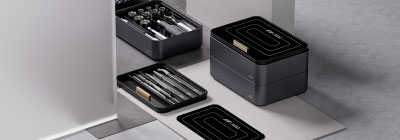
How to Store Your Power Tools: A Science-Backed Guide for Longer Life and Safer Use
Power tools are an investment—they save time, improve results, and make DIY and professional projects possible. But without proper care and storage, even the best tools can deteriorate: batteries lose capacity, metal parts corrode, and small components get lost or damaged. This guide provides a clear, science-based approach to storing power tools so they remain reliable, safe, and ready for use. Throughout, we’ll reference the JIMIHOME X1-C 12V Power Drill Set as a practical example of modern tool storage and maintenance solutions.
1. Why proper storage matters
Tools degrade in storage mainly through three processes:
- Corrosion and oxidation: Humidity causes steel and iron to rust. Even minimal moisture over time creates surface rust, which worsens with temperature fluctuations.
- Battery chemical decay: Lithium-ion batteries, common in cordless tools, suffer capacity loss faster at high temperatures or when stored fully charged or fully discharged.
- Mechanical wear and contamination: Dust, grit, and chemical vapors can abrade moving parts and contaminate electrical contacts. Seals and lubricants also dry out over time.
Good storage prevents these problems by keeping tools dry and cool, maintaining batteries at proper charge levels, and protecting moving parts from contaminants.
2. Clean and inspect before storing
A quick maintenance routine before storage is one of the most effective steps you can take:
- Wipe tools clean: Remove dust, grease, and debris with a lint-free cloth. For stubborn grime, use a mild detergent and soft brush, avoiding solvents that may damage plastic or paint.
- Blow out vents: Compressed air can clear dust from vents and crevices. Hold the motor shaft to prevent spinning. Clean vents help cooling during next use.
- Check for damage: Inspect cords, housings, screws, and contacts for wear, cracks, or looseness. Repair any issues before storing.
- Lubricate moving parts: Apply a thin layer of manufacturer-recommended lubricant to gears, slides, and chucks. Wipe away excess to avoid dust accumulation.
Example: For the JIMIHOME X1-C, remove drill bits and screwdriver bits, wipe the chuck area, apply light lubrication to the chuck threads, and store the bits separately to prevent rust.
3. Battery care
Batteries are both expensive and sensitive to storage conditions:
- Charge level: Store lithium-ion batteries at 40–60% charge to minimize chemical stress and slow capacity loss. Avoid fully charged or fully drained storage.
- Temperature: Keep batteries in a cool, dry place—ideally 15–25°C (59–77°F). Avoid attics, trunks, or uninsulated sheds with extreme temperature swings. High heat will permanently reduce capacity.
- Periodic checks: If unused for months, check voltage every 2–3 months and recharge to storage level if necessary.
- Separate storage: Remove batteries from tools and store in original packaging or a protective container. This prevents accidental activation and isolates potential leakage.
Tip: The X1-C 12V 2000mAh battery should be partially charged before storage and kept out of direct sunlight or heat.
4. Control humidity and temperature
Moisture and extreme temperatures damage metal, electronics, and batteries:
- Keep a dry environment: Relative humidity below 50% is ideal. Use silica gel packs or a dehumidifier if needed.
- Avoid temperature extremes: Avoid storing tools above 35°C (95°F) or below freezing. Thermal cycling promotes condensation.
- Insulated storage: In garages, consider insulated cabinets or indoor closets to maintain moderate temperatures.
5. Organize and protect small components
Lost bits, sockets, or screws waste a lot of time:
- Use molded cases or foam organizers: Keep each piece in a designated spot. The X1-C’s molded case ensures every component is secure and easily checked visually.
- Label containers: Transparent bins with labels simplify retrieval and prevent duplicate purchases.
- Magnetic strips and pegboards: Store frequently used tools for quick access while keeping delicate electronics in closed cabinets.
6. Long-term storage best practices
For seasonal or multi-month storage:
- Cycle batteries every 3 months: Recharge to 40–60% and disconnect.
- Run tools briefly: Power tools on for a few seconds every few months to redistribute lubricants and prevent seizing.
- Use corrosion inhibitors: Light oil or specialized anti-rust sprays protect metal parts. Avoid thick grease that attracts dust.
7. Cord and electrical safety
Corded tools need special care:
- Inspect cords: Check for cuts, exposed wires, or damaged plugs before storage and use. Repair or replace as necessary.
- Coil cords properly: Use loose loops secured with Velcro; avoid tight kinks that break wires.
- Keep cords off the floor: Elevation protects against moisture and pests.
8. Theft and misuse prevention
Proper storage reduces risk of accidental use and theft:
- Lockable cabinets: Secure valuable tools.
- Remove batteries: Prevents theft and accidental starts in shared garages.
- Keep manuals and parts lists together: Ensures proper maintenance and repairs in the future.
9. Quick checklist before storing tools
- Clean surfaces and vents.
- Remove and store accessories separately.
- Lightly lubricate moving parts.
- Remove batteries and store at recommended charge.
- Store tools in dry, temperature-stable cabinets or cases.
- Note the next inspection date.
10. Conclusion
Small, consistent habits—wiping tools, removing batteries, replacing accessories—accumulate into years of reliable performance, fewer failures, and lower replacement costs. Whether you have one cordless drill or a full workshop, following these science-based storage practices keeps tools efficient and safe.
For tools like the JIMIHOME X1-C 12V Power Drill Set, take advantage of the molded case, separate battery storage, and manufacturer maintenance guidance. A little attention to storage today ensures dependable performance for every project tomorrow.




Leave a Comment